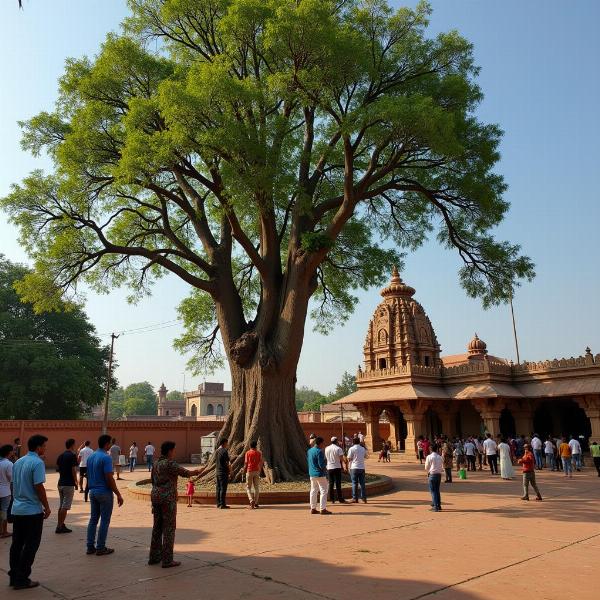The term “ashwath meaning in Hindi” often leads to a simple translation – peepal tree. However, the significance of the Ashwath tree, known scientifically as Ficus religiosa, transcends a mere botanical definition. It embodies deep cultural, religious, and even philosophical connotations within Indian society. This article delves into the multifaceted meaning of Ashwath, exploring its symbolism, significance in Hinduism, and its place in everyday Indian life.
The Symbolism of the Ashwath Tree
The Ashwath tree is revered as a sacred symbol in Hinduism, Buddhism, and Jainism. Its long lifespan, evergreen nature, and expansive root system have led to its association with immortality, eternity, and the interconnectedness of life. The tree is often depicted in ancient scriptures and art, symbolizing the cosmos, wisdom, and the divine. It’s believed that Lord Krishna delivered his final sermon, the Bhagavad Gita, under the shade of an Ashwath tree, further solidifying its sacred status. Even today, you can often find Ashwath trees planted near temples and homes, serving as a place for prayer, meditation, and community gatherings.
 Ashwath Tree Near Temple
Ashwath Tree Near Temple
Ashwath in Hindu Mythology and Scriptures
The Ashwath tree holds a prominent position in Hindu mythology and scriptures. It is often mentioned in the Vedas, Puranas, and Upanishads, often linked to deities like Brahma, Vishnu, and Shiva. The tree is sometimes referred to as the “Kalpavriksha,” or the wish-fulfilling tree, highlighting its association with prosperity and abundance. In some narratives, the roots of the Ashwath tree are said to extend to the heavens, while its branches spread across the earth, representing the connection between the divine and the mortal realm.
Ashwath in Ayurvedic Medicine
Beyond its spiritual significance, the Ashwath tree also holds medicinal value in traditional Ayurvedic practices. Various parts of the tree, including the bark, leaves, and fruits, are used to treat a range of ailments, from skin diseases to respiratory issues. The tree is believed to have anti-inflammatory, antioxidant, and antimicrobial properties, making it a valuable resource in traditional medicine.
Ashwath and Environmental Significance
The Ashwath tree plays a crucial role in maintaining ecological balance. Its dense foliage provides shade and shelter for various creatures, while its extensive root system helps prevent soil erosion. The tree also contributes to air purification, absorbing carbon dioxide and releasing oxygen. Given its ecological importance, protecting and preserving Ashwath trees is essential for environmental sustainability.
The Ashwath Tree in Modern India
Even in modern India, the reverence for the Ashwath tree continues. It’s not uncommon to see people offering prayers and tying sacred threads around the trunk of the tree, seeking blessings and fulfilling vows. The tree remains a powerful symbol of faith, resilience, and the enduring connection between humans and nature.
Conclusion
The “ashwath meaning in Hindi” encapsulates much more than just a name. It represents a deep-rooted cultural and spiritual symbol interwoven with the fabric of Indian society. From its religious connotations to its medicinal and environmental importance, the Ashwath tree continues to hold a significant place in the lives of many Indians, serving as a reminder of the interconnectedness of life, the power of nature, and the enduring legacy of tradition.
FAQ
-
What is the other name for Ashwath tree? Peepal tree is the most common alternative name for Ashwath.
-
Why is the Ashwath tree considered sacred? Its longevity and evergreen nature symbolize immortality and eternity, linking it to divine concepts.
-
What is the significance of Ashwath in Ayurveda? Various parts of the tree are used for their medicinal properties in traditional Ayurvedic practices.
-
Where is the Ashwath tree usually found? Often found near temples, homes, and in other significant locations throughout India.
-
What is Kalpavriksha? It is another name for the Ashwath tree, meaning the “wish-fulfilling tree.”
-
Is the Ashwath tree environmentally important? Yes, it contributes to air purification, prevents soil erosion, and provides habitat for various species.
-
What is the significance of tying threads around the Ashwath tree? This is a common ritual representing prayers, vows, and seeking blessings.
Meaning-Hindi.in is your trusted partner for high-quality Hindi translation services. We specialize in various domains, including business and commercial documents, legal and certified translations, technical manuals, website localization, and educational materials. Our team of expert linguists ensures accurate and culturally sensitive translations, catering to your specific needs. For professional Hindi translation services, contact us at [email protected] or call us at +91 11-4502-7584. Meaning-Hindi.in is committed to bridging the language gap and facilitating effective communication across cultures.